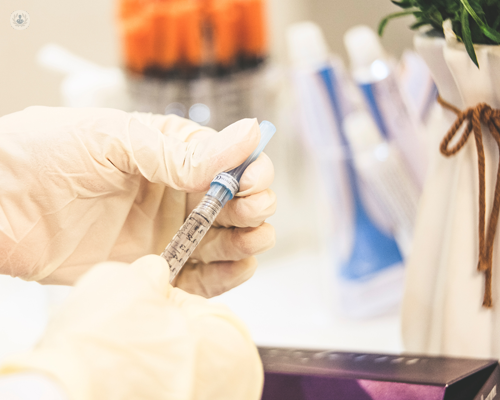Managing diabetic macular oedema
Escrito por:When it comes to diabetic macular oedema treatment, it's a case of reversing or slowing down damage of this eye condition.
Fortunately. there are effective ways to manage this condition, and leading consultant ophthalmic surgeon Mr Hadi Zambarakji provides a detailed insight in this comprehensive article.

What is diabetic macular oedema?
Diabetic macular oedema refers to the vascular leakage within the macular area of the retina. This is a leading cause of vision loss in diabetic patients and a very important indication for treatment with an anti-VEGF injection.
What are the early warning signs of diabetic macular oedema?
Diabetic macular oedema is basically a complication of diabetic retinopathy. Patients tend to present with:
- reduced visual acuity;
- reduced contrast sensitivity, and sometimes;
- distortion of vision.
One should look for it in any patient who has diabetes. And this is done via a clinical examination, but also - and most importantly - with OCT imaging, which allows us to pick up and identify very early signs of diabetic macular oedema. OCT scans are extremely sensitive at identifying thickening of the retina.
How can Anti-VEGF injections help to treat diabetic macular oedema?
In patients with diabetic macular oedema, vascular endothelial growth factor, or VEGF, is significantly present in the eye. In other words, there's a lot of them inside the eye. We know this from a number of studies, and therefore treatment of diabetic macular oedema today is predominately based on anti-VEGF using intravitreous injections. That's the most efficacious way of treated diabetic macular oedema.
If you go back in time, we used to treat diabetic macular oedema with:
- macular laser;
- macular grid laser,
- focal macular laser or;
- modified macular grid laser.
We then went on to use intravitreal steroid injections using triamcinolone, which is another agent that used to be used quite frequently. Now triamcinolone has it's own side effect profile and isn't used very often anymore for treatment.
However, there are other steroids that are being used quite frequently in the setting of diabetic macular oedema. This includes dexymatozone implants and influzalone implants. Both of which have longer duration of effect compared to anti-VEGF agents. It certainly can be very efficacious in the management in diabetic macular oedema.
Is surgery ever necessary to treat diabetic macular oedema?
This is a really important question, which has been addressed by a number of publications already. The question is basically, can we actually relieve diabetic macular oedema by operating on the eye? And operating on this, I mean performing vitreous retractive surgery and peeling the internal-limiting membrane over the macular area.
The studies done in this context, in general, have shown that surgery isn't an efficacious treatment for diabetic macular oedema unless there's macular attraction. The role of surgery is when there's traction on the macular, and therefore surgery is designed to release traction but not for simply treating macular oedema due to vascular leakage with no signs of traction.
In short, surgery is a benefit if there's peeling of the internal-limiting membrane. It's a benefit if there is evidence of traction on the macular.
Are there any other ways to slow or reverse progression of diabetic macular oedema?
When the patient presents at the clinic with reduced vision and diabetic macular oedema, the first and most important point to address is whether or not their diabetes is being well managed or not. Therefore, optimising vascular risk factors, so:
- diabetic control;
- blood pressure;
- cholesterol;
is absolutely essential.
Sometimes weight loss, adjustment of diet and increasing exercise, too. So, anything and everything that's been done in general by diabetologists and their teams to optimise diabetes management is important in a setting of managing diabetic macular oedema.
From an ophthalmic point of view, we tend to home in, in particular, into our interventions such as laser-based treatments or injection-based treatments. We must never forget the importance of systemic management of the patient, as well.
If you require expert diabetic macular oedema management, arrange a consultation with Mr Zambarakji via his Top Doctors profile.


